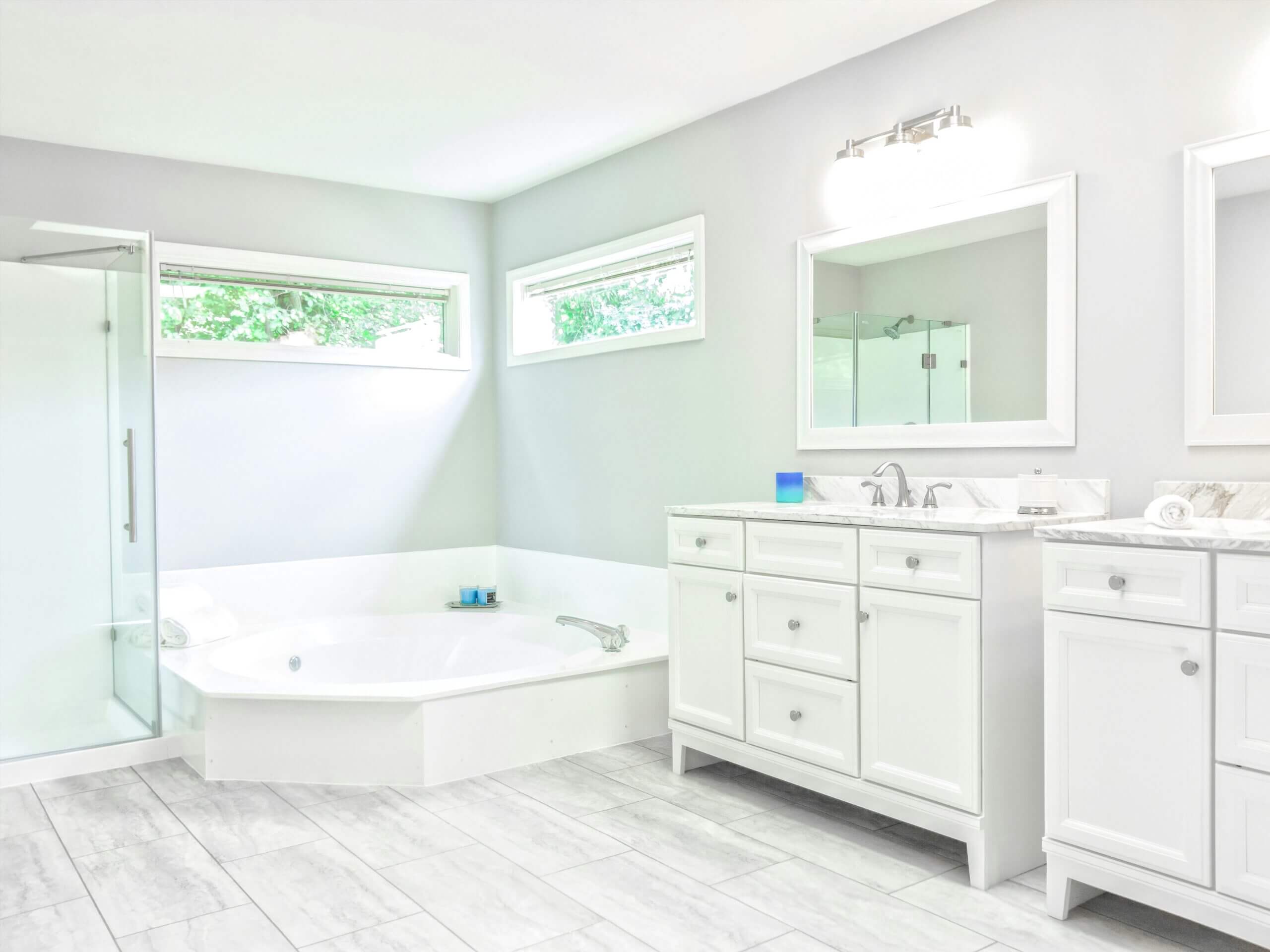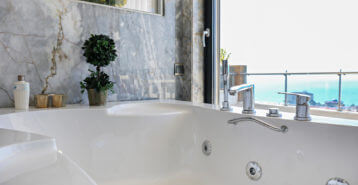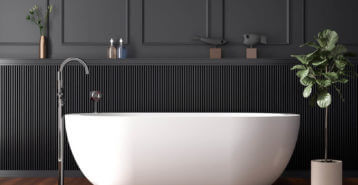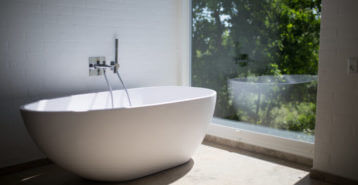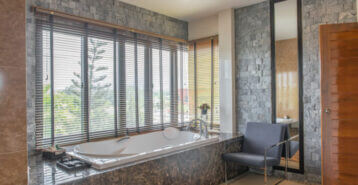Corner tubs are one among the more unique options for your bathroom. They are growing in popularity due to their unique shape and size, the way they fit into some unlikely small spaces, and how they provide so many options for soaking, jets, and more.
Let’s take a look at corner tubs, including the costs you should expect, to help you find the one that’s just right for your unique space.
What Is a Corner Tub?
Corner tubs are exactly what they sound like: bathtubs that are specifically designed to fit into corners, thus using up floor space in the bathroom that might otherwise go to waste.
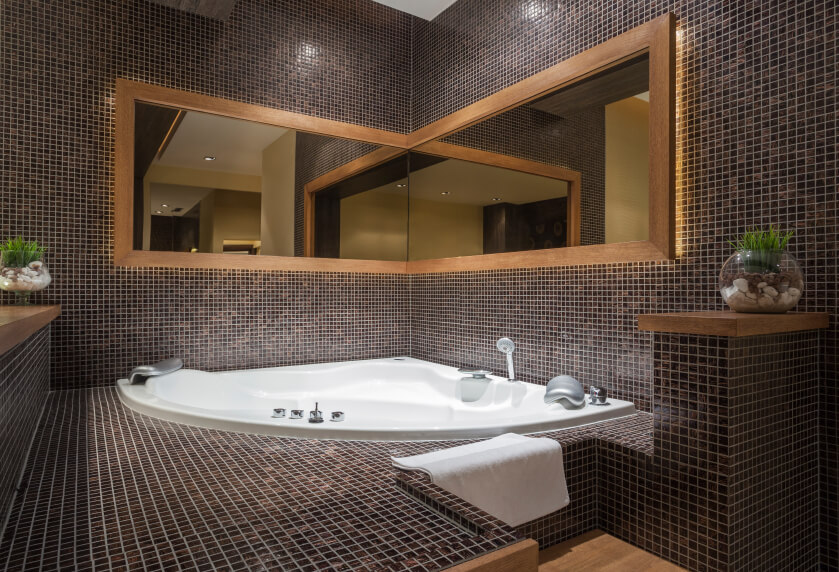
In addition to the practicality of corner tubs, there is also the added benefit of unique design options, a luxurious ambiance, and a good soaking experience. Corner tubs are often larger than a typical bathtub and thus can usually hold two people. You can also expand the use of a corner tub by enclosing it with glass shower panels to create a shower-tub combo.
Corner tub designs include interior basins that are shaped to suit your preferences, such as oval, hourglass, rectangular, or even round models. Some have therapeutic water or air jets for a more luxurious experience. Comfortable armrests and shelves are possible here, so you have plenty of room for toiletries, candles, and other amenities.
Is a Corner Tub Right for You?
Corner tubs are right at home in tiny bathrooms where space it at a premium or in large bathrooms where they are a well-considered design option that adds spa-like appeal. They make very efficient use of space for those who have a small bathroom that might not work well with a traditional bathtub, and the fact that you can turn it into a tub-shower combo makes it even more suitable.

A corner tub is often built in, but some corner tubs are freestanding models that can provide even more space around them for storage or simply for moving around a tight bathroom.
When deciding if a corner tub is right for you, consider the following points.
- A corner tub can be more expensive to install than a typical tub, but it can also come with more options and advantages.
- Corner tubs might be trickier to enter and exit, but that can be helped somewhat with a wide built-in around it for seating, as well as grab bars placed in strategic locations for safety.
- Cleaning a corner tub might be more difficult, thanks to the need to reach deep into a corner to clean away soap scum.
- Because corner tubs can be larger than traditional tubs, they can use much more water. Make sure you have a water heater that can keep up with the demand.
- Installing a corner tub in a bathroom that used to hold a traditional tub can mean rerouting the pipes and adjusting the plumbing, which can add to the bottom line and the time it takes to install the tub.
How Much Does a Corner Tub Cost?
A corner tub can cost anywhere from $700 to $5,000 and up. The cost depends upon many factors, including the size, material, brand, quality of the tub, and any additional features you might choose. Installations costs come into play as well.
- Size and material. Obviously a larger tub will be more difficult to install, simply due to the weight and the unwieldiness of the product. The most common material for corner tubs is acrylic thanks to it being lightweight and more affordable.
- Brand and quality. Some brands are more expensive than others. For instance, a Jacuzzi corner tub is likely to be more expensive than one produced by Kohler or American Standard. Each brand has high-quality options, but those of the highest quality will usually come with long-term warranties to showcase that quality, which in turn leads to a higher price.
- Additional features. A simple corner tub with no bells and whistles will always be more affordable than a tub that has extra features such as water or air jets, aromatherapy, LED lighting, or even an integrated stereo system.
- Labor costs. Keep in mind that labor costs can vary widely from one geographical area to another. Doing this job yourself is only recommended if you have extensive experience with construction and renovation. Otherwise, hiring a professional contractor will ensure the job is done right and keep any warranties on the tub in place.
Remember that adding a water heater to keep up with increased demand or moving around plumbing lines to accommodate the location of the new tub can add up to $2,000 to your bottom line. If you must demolish an old tub to make room for the new one, you will likely have to work on remodeling the floors and walls as well, which can turn into a major project.
Corner Bathtub Materials
The materials for a corner bathtub might sound familiar because they’re the same materials that you might choose for other bathtubs. However, some are more popular than others:
Acrylic and Fiberglass
Acrylic and fiberglass are the top choices for corner tubs. This is thanks to their affordability as well as being lighter, and thus easier to move around in tight spaces. In many cases, the tub is actually fiberglass covered in sheets of colored acrylic. These tubs are long-lasting, low-maintenance, and can come in a wide variety of colors and styles to suit your design needs.
-
Pros
- Lighter and thus easier to move around
- Quite affordable compared to other materials
- Little maintenance required
- Comes in a wide variety of styles and colors
-
Cons
- Doesn’t have the best heat retention
- Scratches might readily show with darker colors
Cast Iron
Cast iron tubs are made of molten iron poured into a mold. The durability of cast iron is unmatched; with proper care, it can last for hundreds of years. They also retain heat better than other options do. The downside is that cast iron is heavy – extremely so, especially when installing a larger-than-usual tub. For that reason, many contractors will only install these tubs on the ground floor of a home. Cast iron tubs might require a higher installation cost.
-
Pros
- Longevity is unmatched
- Heat retention ensures a more comfortable soak
- A stand-alone tub can be passed down through generations
-
Cons
- Cast iron tubs are very heavy
- Limited in where you can place the tub
- Higher installation costs
Stone and Wood
These unusual materials serve as an eye-popping design option in your bathroom. Stone resin, which is made of resin and natural stone, are quite durable and retain heat almost as well as cast iron does. But just as with cast iron, a stone tub can be much heavier than the other options.
A corner tub made of wood is a unique option that won’t be found too in many homes, but it does require more maintenance and might be pricier. It might also require more work to install.
-
Pros
- Unique design option
- Durable
- Good with heat retention
-
Cons
- More expensive than other options
- More difficult to install
Porcelain on Steel
This is a long-lasting and affordable option. It’s heavier than acrylic but not as heavy as cast iron. The heat retention also falls somewhere between the two extremes. Porcelain on steel is heavy but not too heavy to warrant a higher installation fee. However, the tub is more likely to chip or rust, which means that it won’t last as long as other options – though it can still last for decades with good care. This material can look very much like cast iron.
-
Pros
- Affordable option
- Decent heat retention
- Can mimic higher-end materials, like cast iron
-
Cons
- Can chip, crack, or rust
- Can be tougher to install than lighter options
Types of Corner Bathtubs
Corner tubs come in a wide array of bathtub types, from simple and straightforward to loaded with bells and whistles. Here’s what to expect from each.
- Standard corner tubs are anywhere from three to five-sided installations that are relatively easy to drop into a corner of the bathroom. They might be deeper than the average traditional tub but not nearly as deep as a soaking tub. They might also convert very well to a tub-shower combo.
- Corner soaking tubs are designed to allow a person to sink into the water up to their shoulders or even their neck, if they were so inclined. These tubs might need some support underneath them to handle the weight of the water.
- Corner whirlpool tubs are loaded with jets, powered by either air or water, that offer a soothing and therapeutic soak. These are often a combination of soaking tub and whirlpool tub. These require an electrical connection, so keep in mind that’s an added expense.
- Walk-in corner tubs are designed with a door at the front, which lowers the threshold and allows you to walk into the tub instead of step over the lip. This can provide safety and peace of mind. These tubs might be easier to clean but can take more effort to install, as they can be heavier than a typical corner tub.
- Freestanding corner tubs are those that don’t require dropping into a surround or creating a cabinet around them. Rather, these tubs are more like claw-foot tubs in that they sit in the corner and take up less space than a traditional tub would. Choosing a freestanding tub gives you many more design and layout options.
All of these tubs can include a variety of other options, including seats for one or two people, heaters that keep the water warm while you soak, colored lights for mood, and Bluetooth to allow you to listen to music or podcasts while you bathe.
Corner Tub Sizes and Dimensions
The smallest corner tubs run about 48 inches by 48 inches in length and 18 to 21 inches in width. That’s small enough to fit into a bathroom with limited space. This tub holds anywhere from 60 to 70 gallons. This is on a par with a traditional tub, which can typically hold about 70 gallons.
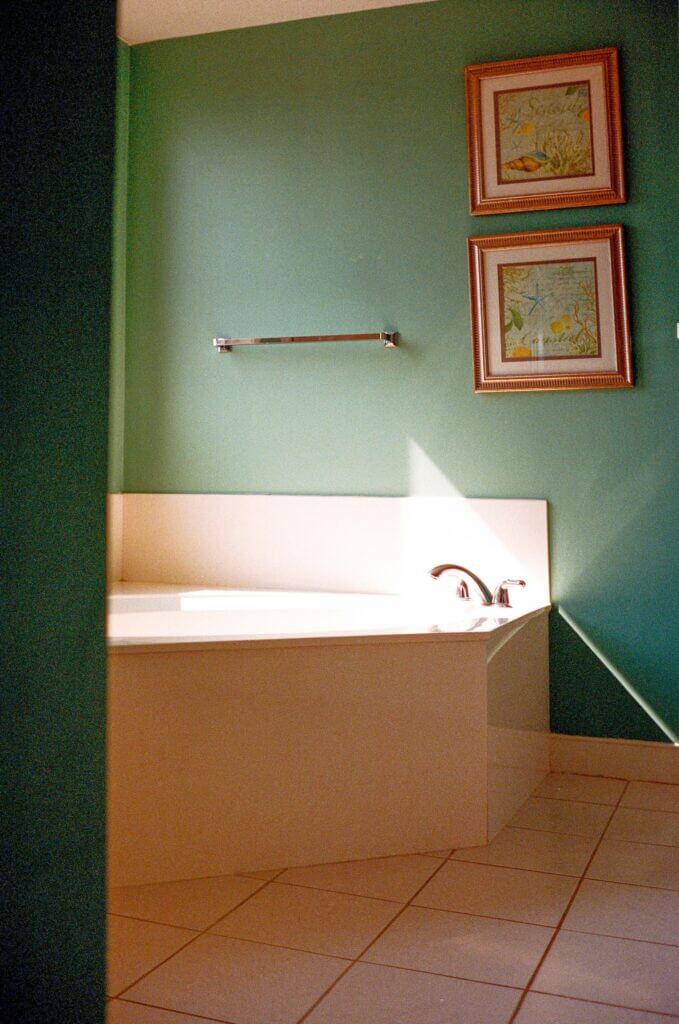
A medium-sized corner tub is typically about 60 inches by 60 inches in length and 18 to 21 inches in width, though this number can go up depending upon the tub you choose. These tubs hold 75 to 80 gallons of water, which is why they can benefit from a larger water heater or on-demand heater.
A larger corner tub can be as long as 72 inches (that’s six feet!) and holds 85 to 90 gallons. These tubs are big enough for a luxurious master bath but might require reinforcement on the floor underneath. Tubs of this size will definitely need a larger water heater or a heater in the cabinet of the tub itself to keep the water from cooling before you can even get into the bath.
![]()
To choose the right bathtub for you, start with the available space. If you already have a bathtub in there, you will need to demolish it to make way for the new one. What sort of space will you have when your new tub is installed? Keep in mind that in order for proper function of the bathroom, the fixtures should have at least 15 inches between fixtures and allow for at least 24 inches of clear space in front of a toilet or bidet.
If you have a unique bathroom layout, a corner tub can make it pop in a way that no other tub could manage. To create something gorgeous out of the space, talk to a contractor or interior designer to determine the best course of action to turn your space from ho-hum to Wow.
Choosing the Best Corner Bathtub for Your Home
Installing a new bathtub is a big decision, especially if you are looking at a tub that is a bit unusual. Look for a corner tub that suits your space and design requirements, but also one that fits into your budget. If you need help finding the best contractors in your area to help, Modernize has you covered — we can match you with the right professional to get the job done.
Compare top-rated bathroom remodel pros in your area.
Read real homeowner reviews, explore qualifications, and view promotions. Modernize makes it easy to browse professionals and find one that will be perfect for your project.
